
CHEF SPOTLIGHT: GABE ERALES OF DAI DUE TAQUERIA
01/19/18 — Heydon Hatcher
This week we are honored to have had the immense pleasure of conducting our inaugural Chef Spotlight series with the highly skilled and seemingly ubiquitous, Gabe Erales. Hailing from El Paso with deep familial roots in the Yucatan, Gabe is a Renaissance family man trained as a mechanical engineer. He is also the head chef for the freshly opened, Dai Due Taqueria at the new FareGround food hall in the heart of Downtown Austin.
We met at the new downtown location (lauded by Money Inc as one of the seven most anticipated food hall openings in the world) shortly before the grand opening this week, a stunning space designed by none other than Michael Hsu, and learned all about Gabe's cooking tenure, his influences, and his undying passion for a bona fide and carefully constructed taco. Get to know this guy, and get down to the new Dai Due Taqueria pronto, you won't regret it.
![]() Gabe Erales leaning on the corn grinder in the Dai Due Taqueria kitchen. Photo by Timothy Patrick Clancy.
Gabe Erales leaning on the corn grinder in the Dai Due Taqueria kitchen. Photo by Timothy Patrick Clancy.
Where are you from and how did you get into cooking?
I grew up in El Paso, Texas… west Texas on the border. I got into cooking mostly because of the influence of Mexican cooking from my mom and dad. My family actually came from Mexico in the Yucatan peninsula, Quintana Roo, to El Paso. My mom was always cooking for a big family. I have 5 brothers and a sister, there are 7 of us in total. She was always doing large format style cooking to keep us all fed. One thing that stands out in my mind is she would make cochinita pibil which is something that we have on the menu here. It’s really special to me, it’s a pork braise that is wrapped in banana leaves and cooked in sour oranges, annatto seeds, chiles (it’s bright red), and served with pickled onions and habaneros. We are doing the same thing here but with feral hog. It’s delicious. That kind of stuff, tamales and general Mexican preparations that she grew up eating and feeding to me, really sparked my interested in cooking. Above all, I started working in kitchens when I was 15 because my older brothers were already working in restaurants as their after school jobs. That was my way of making money ever since I started cooking with an exception of a brief period after school… I started as a busboy at Steak and Ale, moved to prep, and worked in restaurants all through high school. I moved to Austin to attend UT and was supporting myself in restaurants while I was studying engineering. I actually have a Bachelors and Masters in mechanical engineering. While I was studying, I was working in restaurants and basically running from school to work, and from work to studying. After I graduated from UT, I was working for General Motors in Detroit doing design. I started really missing cooking and being in the kitchen, so I got back into it and it's kind of been full speed ever since. I've always been doing a million things at once it's always been a good balance for me.
![]() Yummy meats on a spit. Photo by Timothy Patrick Clancy.
Yummy meats on a spit. Photo by Timothy Patrick Clancy.
Where all have you cooked in town?
I've worked at Fonda San Miguel, and that was a really big influence for me because I feel like because they were the institution of Mexican cooking in town. They were probably the first people to do nixtamalization and fresh masa in house daily, which most people use flour maseca… fresh masa in house makes a huge difference. They have incredible moles, and very authentic regional preparations. Miguel Ravago, the founder, owner, and chef, who recently passed away last year, was involved with a lot of really notable chefs and would involve them in his menu. A lot of great chefs have passed through that establishment. Diana Kennedy was always there consulting on moles which is huge, huge, huge. I worked at La Condesa (under Rene Ortiz) which also had a ton of great chefs passing through there as well. Their food is amazing... Rick, who is still the chef there, is doing an amazing job. I worked at Odd Duck and Qui. I helped open Dai Due - the sister restaurant to this Taqueria, and I helped open up the Geraldine’s restaurant in the Hotel Van Zandt (was there for about two years, as sous chef). I left there to go work in the test kitchen for the Noma Mexico team with Rene Redzepi and helped with the menu development in Tulum. When I returned I was focusing on this project, and that’s what I’ve been involved with ever since.
Tell us about your newest project!
Well, this is the Dai Due Taqueria. It’s located in the new FareGround food hall on Cesar Chavez and Congress. There are 6 permanent restaurants here along with a full bar. I'm head chef here. Jesse Griffith obviously is still the chef and owner at both restaurants, but as far as menu and the day to day operations, I'm your guy.
![]() Dai Due Taqueria at FareGround. Photo by Timothy Patrick Clancy.
Dai Due Taqueria at FareGround. Photo by Timothy Patrick Clancy.
What item are you most excited about on your menu?
There are two things. Number one is the trumpo, it’s the meat over there that looks like a gyro meat. We call it the trompo al pastor. It's very special because we're cooking over Texas charcoal, which a friend of mine makes here in town. The actual meat is wild boar, it's been brined and marinated. I think everyone loves an al pastor taco, so this is really, really special. Also, there's a torta called a pambazo. It's essentially a torta bread that's been dipped in very spicy chili broth. We take bone broth and infuse it with a lot of chiles. It's really bright red and really thick with a lot of body, kind of like a ramen broth. Then we get the torta, and fill it with wild boar chorizo, potatoes, avocado, and cheese. All of that gets melted together, then dipped in that broth, and then regrilled on a flat top. It’s this bright red sandwich that's crispy, has some char marks, and when you bite into it you get this really nice crispy cabbage and radish taste, too. It’s a very Mexico City style torta. I've yet to see one of those in the city here in Austin so I'm really excited that we're kind of introducing our version of it to people.
![]() The trompo meat. Photo by Timothy Patrick Clancy.
The trompo meat. Photo by Timothy Patrick Clancy.
What is the most surprising thing about working with farms?
I think the most surprising thing to me is that for the longest time people just accepted what was sold. You go to the farmers market, there's carrots, cabbage, cauliflower, garlic, and onions… and you worked with that. However, the relationship between the farmer and the chef has grown so much. Now we partner together, I tell a farmer what I want for my menu, and then they in turn buy seed and try to grow ingredients accordingly. People are growing stuff that you would have never seen grown in Texas previously! There's a girl here in town who's growing extremely rare chiles, chihuacles, and those are even rare in Mexico. So, for them to be grown in Austin is mind-blowing and exciting. I'm working with other people here that are growing some special Mexican herbs, and I have stuff that I brought back from Mexico, a wild mexican spinach.
Tell us about your relationship with JBG?
My first introduction to local farmers was through Johnson's Backyard Garden, back when y’all were extremely small. Brent was at all the Farmers Markets himself, and hosting everybody on the farm very often. So, that's why I still do business with JBG... it's really special to me, and I think a lot of the product is just really amazing. Y’all have grown so much - I hear you deliver to Houston, Dallas, San Antonio… wild.
![]() JBG produce in the kitchen. Photo by Timothy Patrick Clancy.
JBG produce in the kitchen. Photo by Timothy Patrick Clancy.
What is the most difficult part about working with farms and sourcing locally?
The most difficult part is the commercial and logistical side of things. People like Farm to Table have changed the game in that it's a one stop shop. You can call them and be like, “I need beets,” and if you have a good relationship with them then they'll send you the best unless you tell them you want some of the cheapest beets they have, and they send you that. It’s a one stop shop, so you aren’t calling 6 different farmers. You aren’t worried about if and when the farm is going to deliver, but on the same token you're paying a premium, so food cost is a big issue. You have to take the extra effort to call all five different farmers instead of just getting the consolidated service from Farm to Table. With farms, schedules and availability can be an issue. It’s first come, first serve, and sometimes when you are planning a menu around a certain veggie and something happens with the harvest or they sell out it can be difficult. However, if you go directly to the farm you’re going to get a better product. There's a lot of farmers that just don't deliver, too, but have amazing product. In a day-to-day operation, it's really hard to break free and go pick up veggies at a farm. You can't really do that all the time… but, there are people who do that in town! Barley Swine’s kitchen goes to the farmers market every Saturday religiously. I admire Bryce and Mark for doing that. It's amazing and there's a special intimacy there. It's hard for everyone to be on that level after long hours the night before in the kitchen.
How do you decide where to source from?
It's always going to be a balance of quality and price. So, if I am using a product that's going to be the showcase of the dish or the meal, then I'm obviously going to be willing to pay a little more premium on a product. If it's something that's going to be cooked and blitzed into a sauce or a garnish that doesn't need to be as robust of a flavor, then you don’t need to spend as much. It's just a give and take. You have to evaluate what the food cost of a plate is versus overall food cost in general, and how much more of a return on your investment you're going to get. If I were to buy Johnson's sweet potatoes versus Tecolote’s, how much better is the flavor for an extra 50 cents? It also depends on availability. I like to provide loyalty to farms, too. If Johnson’s is taking care of me and is always on time, I’m going to keep my commitment to support them. It’s always a relationship, and I feel like in this day and age there are so many farmers that take it really personally. In this day of social media, people’s feelings can really get hurt if you get, let’s say carrots, from someone else. You gotta tread lightly.
![]() Spices at the Taqueria. Photo by Timothy Patrick Clancy.
Spices at the Taqueria. Photo by Timothy Patrick Clancy.
What is the best part about working with local farms?
Obviously, I feel like the sustainability aspect and the return to the community. It's a closed loop cycle. It's really great to have the same farmers that are delivering your food be the same people you're feeding. You get to know their family and their kids, and it goes back to the intimate relationship of working with them and them growing special ingredients for you. Going through US Foods or Sysco, I guarantee you're never going to meet the face of where your product comes from. You don’t know what they’re going through to grow that product or how much care is going into that product. So, I feel like to understand the relationship and intimacy of the farm and how it’s being raised is really special. Same thing goes for animals, too. We use feral hog on the menu because it’s delicious, but also an invasive species. The Spanish brought these pigs hundreds of years ago, and they eventually procreated and took over Texas along with other parts of the country. They cause hundreds of millions of dollars of damage to farms, urban residences, and cemeteries all over the place. They are called wild boar, a little misleading, they are actually out in the wild; however, after they are trapped and killed, they are inspected. It’s not like Jesse goes out and hunts feral hog and just brings it in and throws it on the grill... people actually ask that all the time. He’s an amazing hunter and goes often, but he doesn’t kill these hogs. It’s all about sustainability, there’s tons of feral hog and they are delicious. They love acorns, and it adds this nice malty, nutty flavor to the protein that we cook, too.
Is there anything that you think our readers would be surprised to know about day to day in the kitchen?
The amount of technique that goes into making a taco. I feel like the community's been so inundated with, and not to take anything away from Taco Deli or Torchy's, places that pump out a lot of tacos everyday. You go and wait in line and get your tacos ten minutes later, not to say they're not good, but I don't think the amount of technique and care that's going into making those is on the same level of what we're doing here. We're bringing in Mexican heirloom corn that gets cooked, ground, and made into fresh tortillas daily. It's a lot different than having a truckload of tacos dropped off, and you just reheat them. In my opinion, a taco is only as good as the tortilla it’s served on. You can have a delicious filling, but if the tortilla that’s holding it together is falling apart… it’s not that great. The taco was founded on corn, and that’s the backbone of it all. So we really prize ourselves on our masa program. Day to day, the amount of technique that goes into the sauces, the meat, the butchery… everything.
![]() Heirloom corn. Photo by Timothy Patrick Clancy.
Heirloom corn. Photo by Timothy Patrick Clancy.
![]() Tortilla making process. Photo by Timothy Patrick Clancy.
Tortilla making process. Photo by Timothy Patrick Clancy.
![]() Tortilla making process. Photo by Timothy Patrick Clancy.
Tortilla making process. Photo by Timothy Patrick Clancy.
What’s your favorite vegetable to work with and least favorite?
Easy - I love chiles. I grew up eating chiles with my parents influence. Even as a kid I was eating raw habaneros macerated in lime and salt. Cooking with chiles is really special to me. I love carrots, and I really love corn obviously. It’s also really special to me, and I relish all the different ways it’s used. My least favorite is dandelion greens. I’ve tried cooking them tons of different ways, but they are just a little too bitter for me.
What advice would you give to a home chef who is trying to learn to cook with more seasonal vegetables?
I would say go to the farmers market and pick up something you have never cooked with before. Get on the internet and use it as a resource or use food magazines, like Bon Appetit and Food & Wine. They always have a lot of the latest food recipes and trends for seasonal vegetables. There's a lot of creative stuff that their staff puts together for recipes... it's really inventive and delicious. For savory cooking it doesn't need to be quite as accurate, and you can improvise a lot more. Be adventurous!
![]() Kitchen scenes at the Taqueria. Photo by Timothy Patrick Clancy.
Kitchen scenes at the Taqueria. Photo by Timothy Patrick Clancy.
Any quick recipe or technique you’d like to share with our readers (with something in season)?
I really think right now sweet potatoes are really, really delicious. Something that we're doing on our cochinita pibil taco is pickling them fresh. So, since we don't have red onion right now, we're using sweet potatoes, julienned fresh and then pickled with chile piquin. That pickled sweet potato goes as a garnish on the taco, and it makes an amazing pickled item. My Sous chef, Mike Diaz, came up with the idea. Give it a try!
A huge thank you to Gabe Erales for taking the time to speak with us this week and Timothy Clancy for the amazing photos! Find more photos on his site or on his Instagram.
We met at the new downtown location (lauded by Money Inc as one of the seven most anticipated food hall openings in the world) shortly before the grand opening this week, a stunning space designed by none other than Michael Hsu, and learned all about Gabe's cooking tenure, his influences, and his undying passion for a bona fide and carefully constructed taco. Get to know this guy, and get down to the new Dai Due Taqueria pronto, you won't regret it.
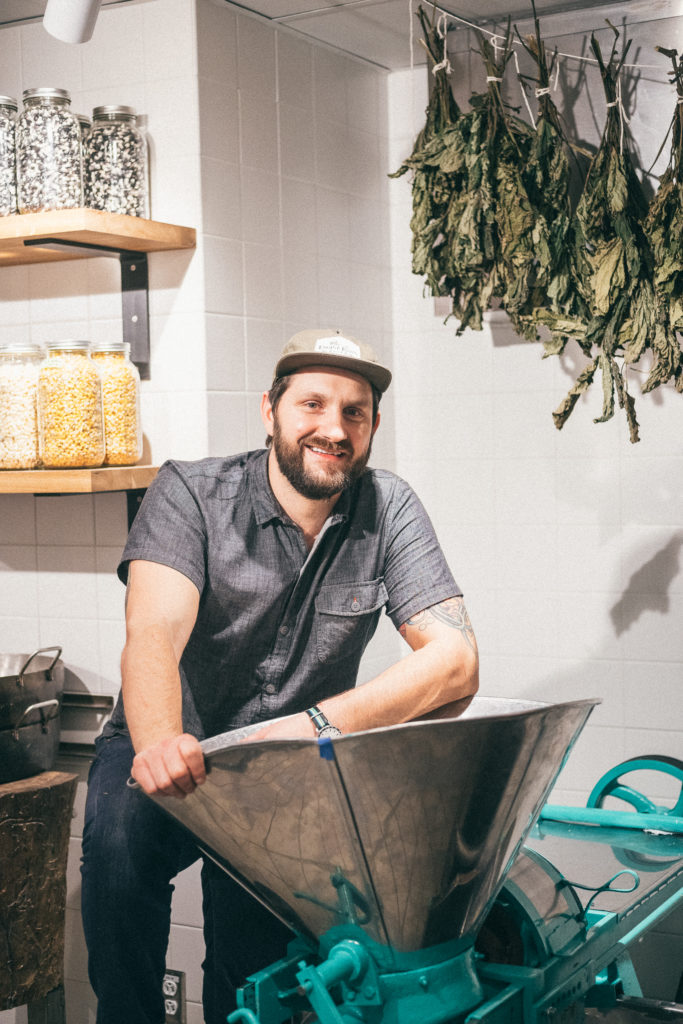 Gabe Erales leaning on the corn grinder in the Dai Due Taqueria kitchen. Photo by Timothy Patrick Clancy.
Gabe Erales leaning on the corn grinder in the Dai Due Taqueria kitchen. Photo by Timothy Patrick Clancy.
Where are you from and how did you get into cooking?
I grew up in El Paso, Texas… west Texas on the border. I got into cooking mostly because of the influence of Mexican cooking from my mom and dad. My family actually came from Mexico in the Yucatan peninsula, Quintana Roo, to El Paso. My mom was always cooking for a big family. I have 5 brothers and a sister, there are 7 of us in total. She was always doing large format style cooking to keep us all fed. One thing that stands out in my mind is she would make cochinita pibil which is something that we have on the menu here. It’s really special to me, it’s a pork braise that is wrapped in banana leaves and cooked in sour oranges, annatto seeds, chiles (it’s bright red), and served with pickled onions and habaneros. We are doing the same thing here but with feral hog. It’s delicious. That kind of stuff, tamales and general Mexican preparations that she grew up eating and feeding to me, really sparked my interested in cooking. Above all, I started working in kitchens when I was 15 because my older brothers were already working in restaurants as their after school jobs. That was my way of making money ever since I started cooking with an exception of a brief period after school… I started as a busboy at Steak and Ale, moved to prep, and worked in restaurants all through high school. I moved to Austin to attend UT and was supporting myself in restaurants while I was studying engineering. I actually have a Bachelors and Masters in mechanical engineering. While I was studying, I was working in restaurants and basically running from school to work, and from work to studying. After I graduated from UT, I was working for General Motors in Detroit doing design. I started really missing cooking and being in the kitchen, so I got back into it and it's kind of been full speed ever since. I've always been doing a million things at once it's always been a good balance for me.
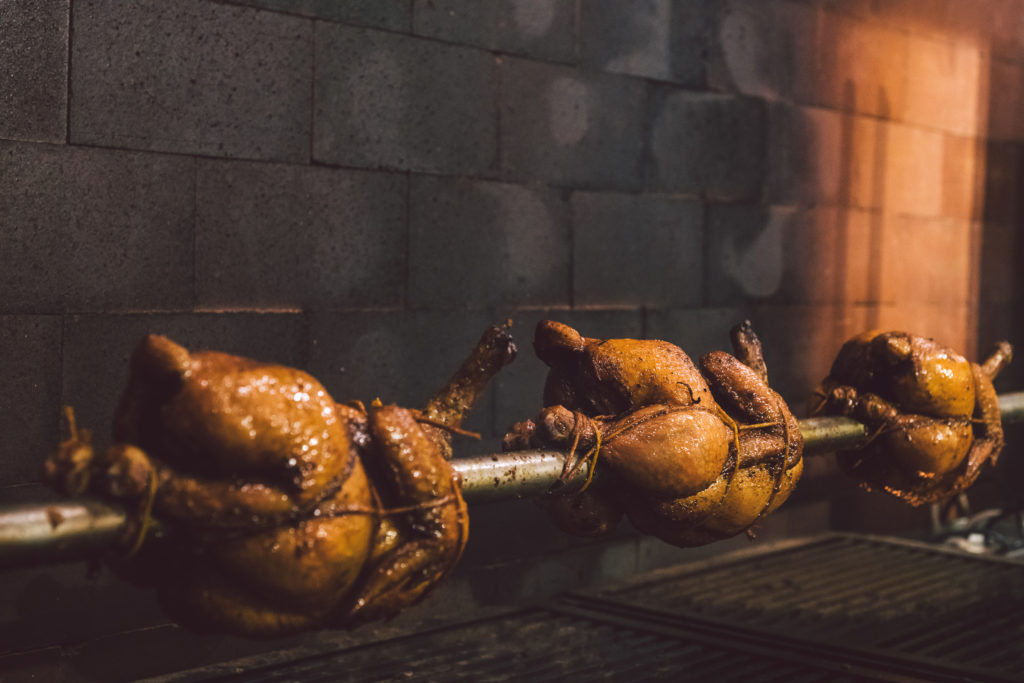 Yummy meats on a spit. Photo by Timothy Patrick Clancy.
Yummy meats on a spit. Photo by Timothy Patrick Clancy.
Where all have you cooked in town?
I've worked at Fonda San Miguel, and that was a really big influence for me because I feel like because they were the institution of Mexican cooking in town. They were probably the first people to do nixtamalization and fresh masa in house daily, which most people use flour maseca… fresh masa in house makes a huge difference. They have incredible moles, and very authentic regional preparations. Miguel Ravago, the founder, owner, and chef, who recently passed away last year, was involved with a lot of really notable chefs and would involve them in his menu. A lot of great chefs have passed through that establishment. Diana Kennedy was always there consulting on moles which is huge, huge, huge. I worked at La Condesa (under Rene Ortiz) which also had a ton of great chefs passing through there as well. Their food is amazing... Rick, who is still the chef there, is doing an amazing job. I worked at Odd Duck and Qui. I helped open Dai Due - the sister restaurant to this Taqueria, and I helped open up the Geraldine’s restaurant in the Hotel Van Zandt (was there for about two years, as sous chef). I left there to go work in the test kitchen for the Noma Mexico team with Rene Redzepi and helped with the menu development in Tulum. When I returned I was focusing on this project, and that’s what I’ve been involved with ever since.
Tell us about your newest project!
Well, this is the Dai Due Taqueria. It’s located in the new FareGround food hall on Cesar Chavez and Congress. There are 6 permanent restaurants here along with a full bar. I'm head chef here. Jesse Griffith obviously is still the chef and owner at both restaurants, but as far as menu and the day to day operations, I'm your guy.
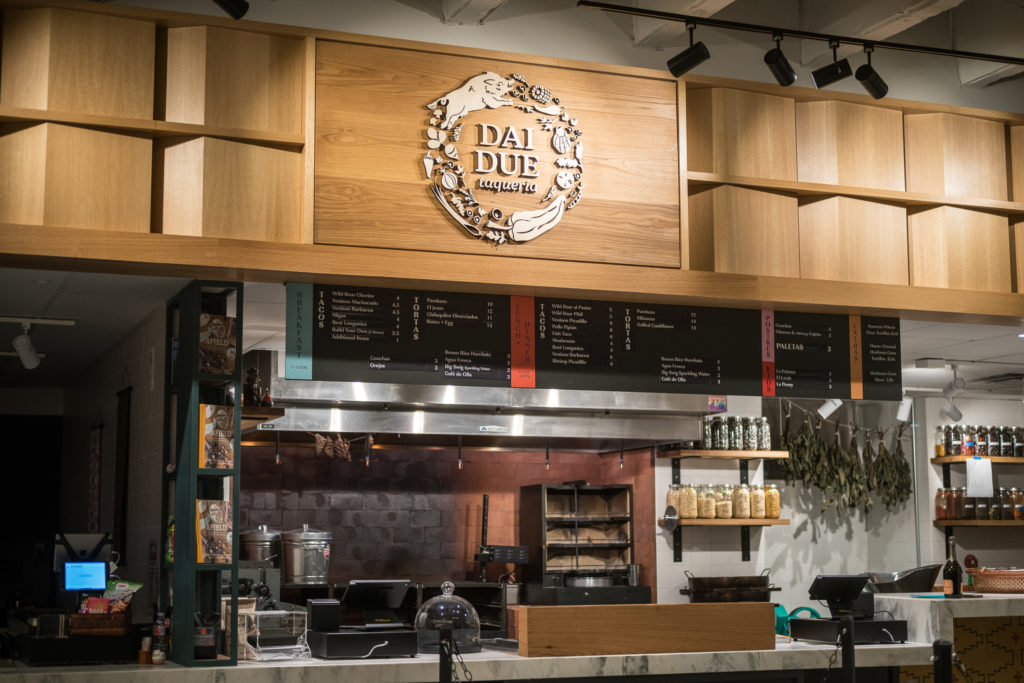 Dai Due Taqueria at FareGround. Photo by Timothy Patrick Clancy.
Dai Due Taqueria at FareGround. Photo by Timothy Patrick Clancy.
What item are you most excited about on your menu?
There are two things. Number one is the trumpo, it’s the meat over there that looks like a gyro meat. We call it the trompo al pastor. It's very special because we're cooking over Texas charcoal, which a friend of mine makes here in town. The actual meat is wild boar, it's been brined and marinated. I think everyone loves an al pastor taco, so this is really, really special. Also, there's a torta called a pambazo. It's essentially a torta bread that's been dipped in very spicy chili broth. We take bone broth and infuse it with a lot of chiles. It's really bright red and really thick with a lot of body, kind of like a ramen broth. Then we get the torta, and fill it with wild boar chorizo, potatoes, avocado, and cheese. All of that gets melted together, then dipped in that broth, and then regrilled on a flat top. It’s this bright red sandwich that's crispy, has some char marks, and when you bite into it you get this really nice crispy cabbage and radish taste, too. It’s a very Mexico City style torta. I've yet to see one of those in the city here in Austin so I'm really excited that we're kind of introducing our version of it to people.
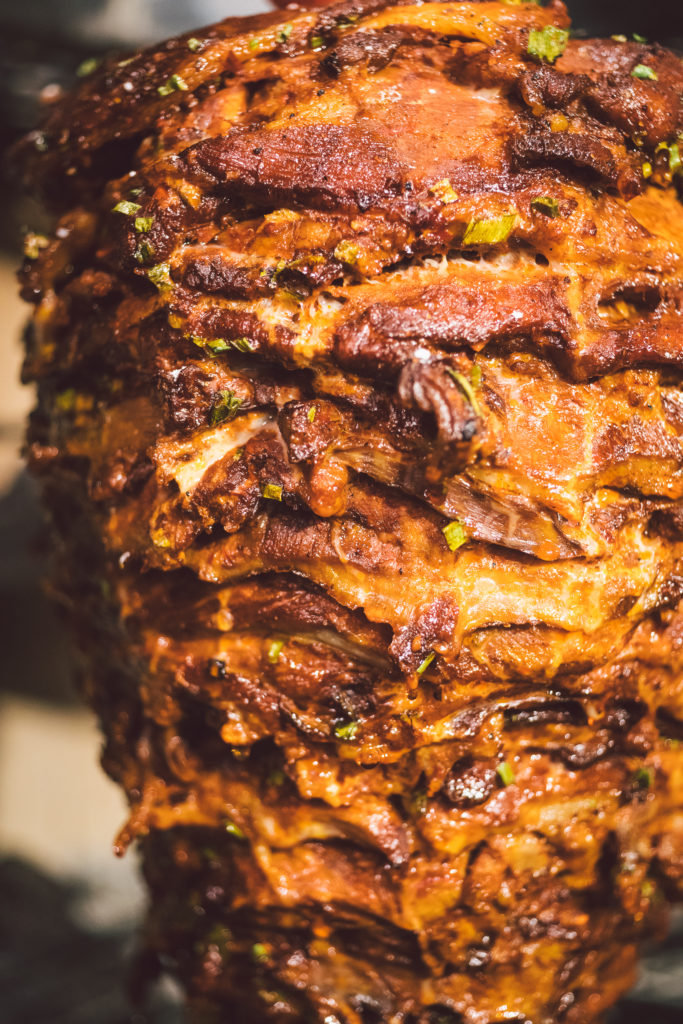 The trompo meat. Photo by Timothy Patrick Clancy.
The trompo meat. Photo by Timothy Patrick Clancy.
What is the most surprising thing about working with farms?
I think the most surprising thing to me is that for the longest time people just accepted what was sold. You go to the farmers market, there's carrots, cabbage, cauliflower, garlic, and onions… and you worked with that. However, the relationship between the farmer and the chef has grown so much. Now we partner together, I tell a farmer what I want for my menu, and then they in turn buy seed and try to grow ingredients accordingly. People are growing stuff that you would have never seen grown in Texas previously! There's a girl here in town who's growing extremely rare chiles, chihuacles, and those are even rare in Mexico. So, for them to be grown in Austin is mind-blowing and exciting. I'm working with other people here that are growing some special Mexican herbs, and I have stuff that I brought back from Mexico, a wild mexican spinach.
Tell us about your relationship with JBG?
My first introduction to local farmers was through Johnson's Backyard Garden, back when y’all were extremely small. Brent was at all the Farmers Markets himself, and hosting everybody on the farm very often. So, that's why I still do business with JBG... it's really special to me, and I think a lot of the product is just really amazing. Y’all have grown so much - I hear you deliver to Houston, Dallas, San Antonio… wild.
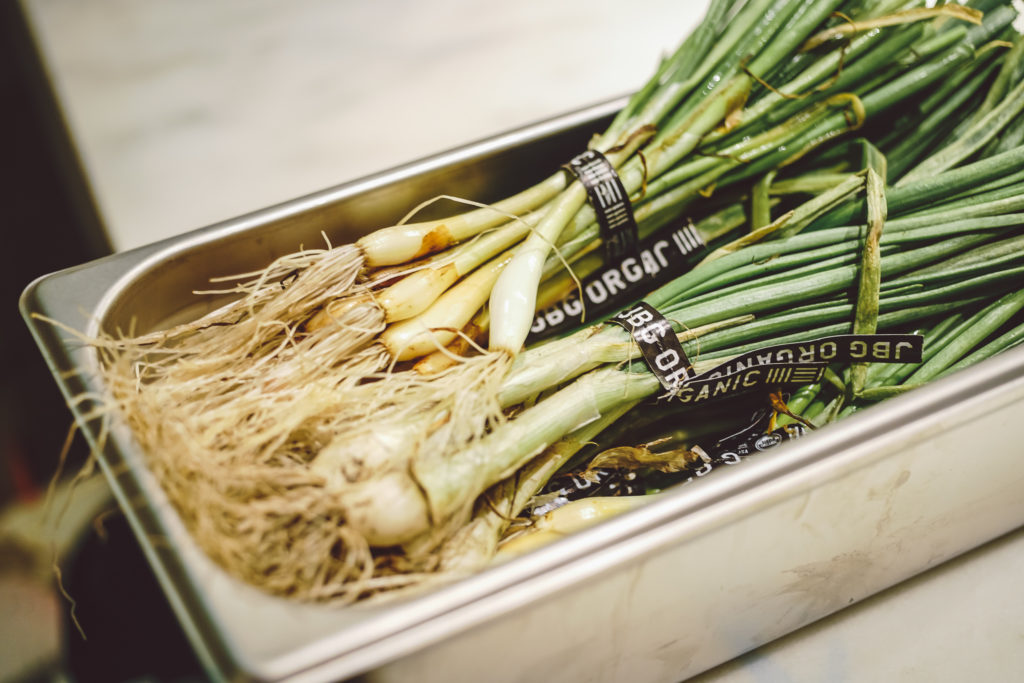 JBG produce in the kitchen. Photo by Timothy Patrick Clancy.
JBG produce in the kitchen. Photo by Timothy Patrick Clancy.
What is the most difficult part about working with farms and sourcing locally?
The most difficult part is the commercial and logistical side of things. People like Farm to Table have changed the game in that it's a one stop shop. You can call them and be like, “I need beets,” and if you have a good relationship with them then they'll send you the best unless you tell them you want some of the cheapest beets they have, and they send you that. It’s a one stop shop, so you aren’t calling 6 different farmers. You aren’t worried about if and when the farm is going to deliver, but on the same token you're paying a premium, so food cost is a big issue. You have to take the extra effort to call all five different farmers instead of just getting the consolidated service from Farm to Table. With farms, schedules and availability can be an issue. It’s first come, first serve, and sometimes when you are planning a menu around a certain veggie and something happens with the harvest or they sell out it can be difficult. However, if you go directly to the farm you’re going to get a better product. There's a lot of farmers that just don't deliver, too, but have amazing product. In a day-to-day operation, it's really hard to break free and go pick up veggies at a farm. You can't really do that all the time… but, there are people who do that in town! Barley Swine’s kitchen goes to the farmers market every Saturday religiously. I admire Bryce and Mark for doing that. It's amazing and there's a special intimacy there. It's hard for everyone to be on that level after long hours the night before in the kitchen.
How do you decide where to source from?
It's always going to be a balance of quality and price. So, if I am using a product that's going to be the showcase of the dish or the meal, then I'm obviously going to be willing to pay a little more premium on a product. If it's something that's going to be cooked and blitzed into a sauce or a garnish that doesn't need to be as robust of a flavor, then you don’t need to spend as much. It's just a give and take. You have to evaluate what the food cost of a plate is versus overall food cost in general, and how much more of a return on your investment you're going to get. If I were to buy Johnson's sweet potatoes versus Tecolote’s, how much better is the flavor for an extra 50 cents? It also depends on availability. I like to provide loyalty to farms, too. If Johnson’s is taking care of me and is always on time, I’m going to keep my commitment to support them. It’s always a relationship, and I feel like in this day and age there are so many farmers that take it really personally. In this day of social media, people’s feelings can really get hurt if you get, let’s say carrots, from someone else. You gotta tread lightly.
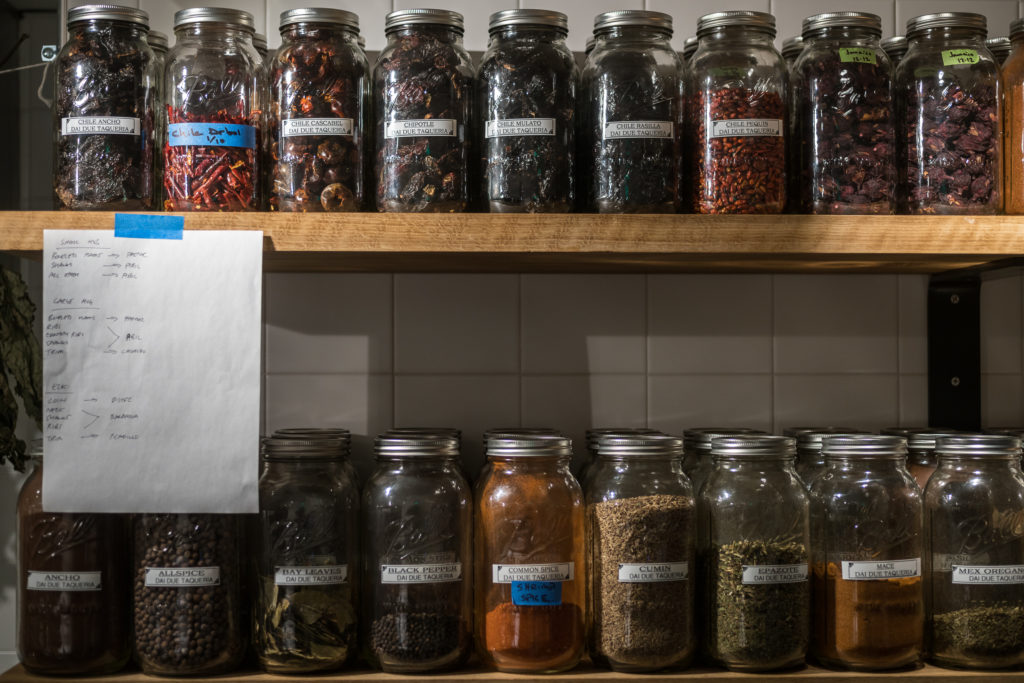 Spices at the Taqueria. Photo by Timothy Patrick Clancy.
Spices at the Taqueria. Photo by Timothy Patrick Clancy.
What is the best part about working with local farms?
Obviously, I feel like the sustainability aspect and the return to the community. It's a closed loop cycle. It's really great to have the same farmers that are delivering your food be the same people you're feeding. You get to know their family and their kids, and it goes back to the intimate relationship of working with them and them growing special ingredients for you. Going through US Foods or Sysco, I guarantee you're never going to meet the face of where your product comes from. You don’t know what they’re going through to grow that product or how much care is going into that product. So, I feel like to understand the relationship and intimacy of the farm and how it’s being raised is really special. Same thing goes for animals, too. We use feral hog on the menu because it’s delicious, but also an invasive species. The Spanish brought these pigs hundreds of years ago, and they eventually procreated and took over Texas along with other parts of the country. They cause hundreds of millions of dollars of damage to farms, urban residences, and cemeteries all over the place. They are called wild boar, a little misleading, they are actually out in the wild; however, after they are trapped and killed, they are inspected. It’s not like Jesse goes out and hunts feral hog and just brings it in and throws it on the grill... people actually ask that all the time. He’s an amazing hunter and goes often, but he doesn’t kill these hogs. It’s all about sustainability, there’s tons of feral hog and they are delicious. They love acorns, and it adds this nice malty, nutty flavor to the protein that we cook, too.
Is there anything that you think our readers would be surprised to know about day to day in the kitchen?
The amount of technique that goes into making a taco. I feel like the community's been so inundated with, and not to take anything away from Taco Deli or Torchy's, places that pump out a lot of tacos everyday. You go and wait in line and get your tacos ten minutes later, not to say they're not good, but I don't think the amount of technique and care that's going into making those is on the same level of what we're doing here. We're bringing in Mexican heirloom corn that gets cooked, ground, and made into fresh tortillas daily. It's a lot different than having a truckload of tacos dropped off, and you just reheat them. In my opinion, a taco is only as good as the tortilla it’s served on. You can have a delicious filling, but if the tortilla that’s holding it together is falling apart… it’s not that great. The taco was founded on corn, and that’s the backbone of it all. So we really prize ourselves on our masa program. Day to day, the amount of technique that goes into the sauces, the meat, the butchery… everything.
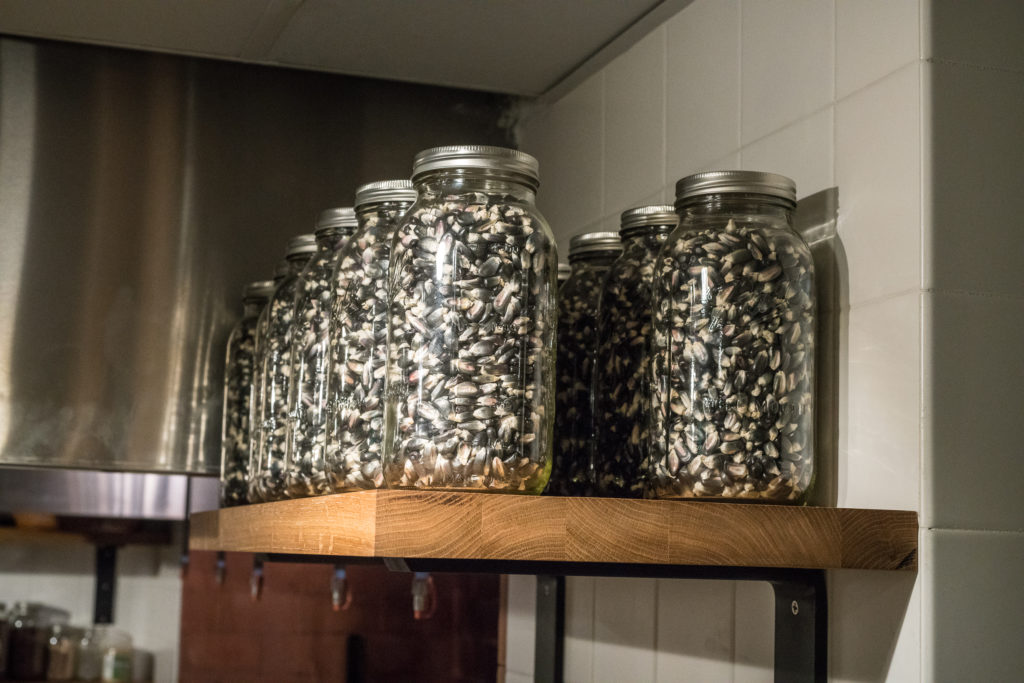 Heirloom corn. Photo by Timothy Patrick Clancy.
Heirloom corn. Photo by Timothy Patrick Clancy.
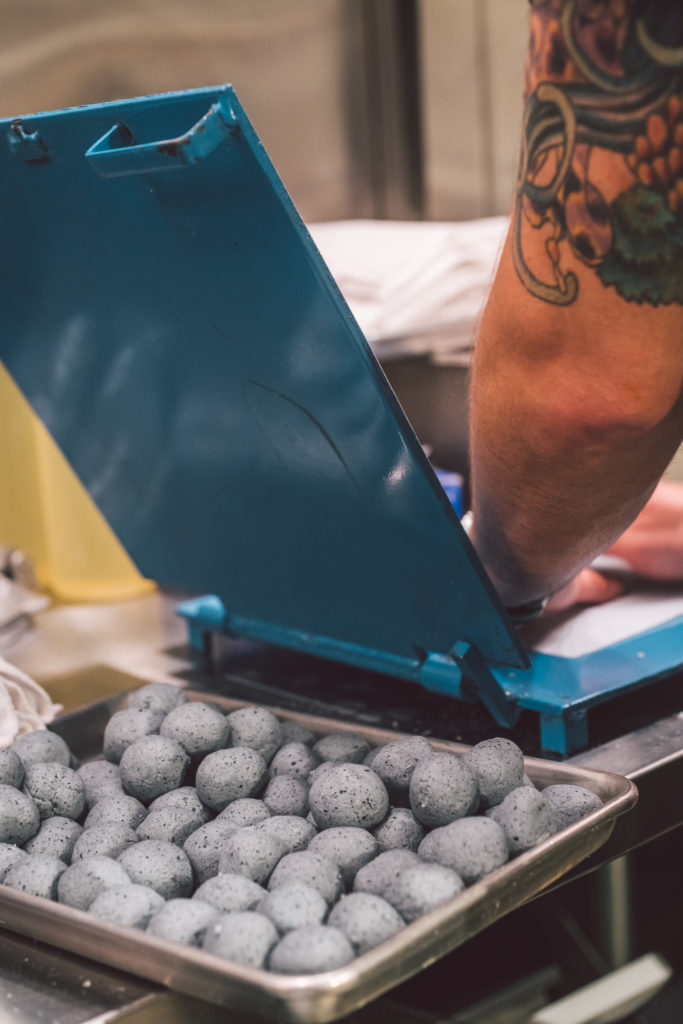 Tortilla making process. Photo by Timothy Patrick Clancy.
Tortilla making process. Photo by Timothy Patrick Clancy.
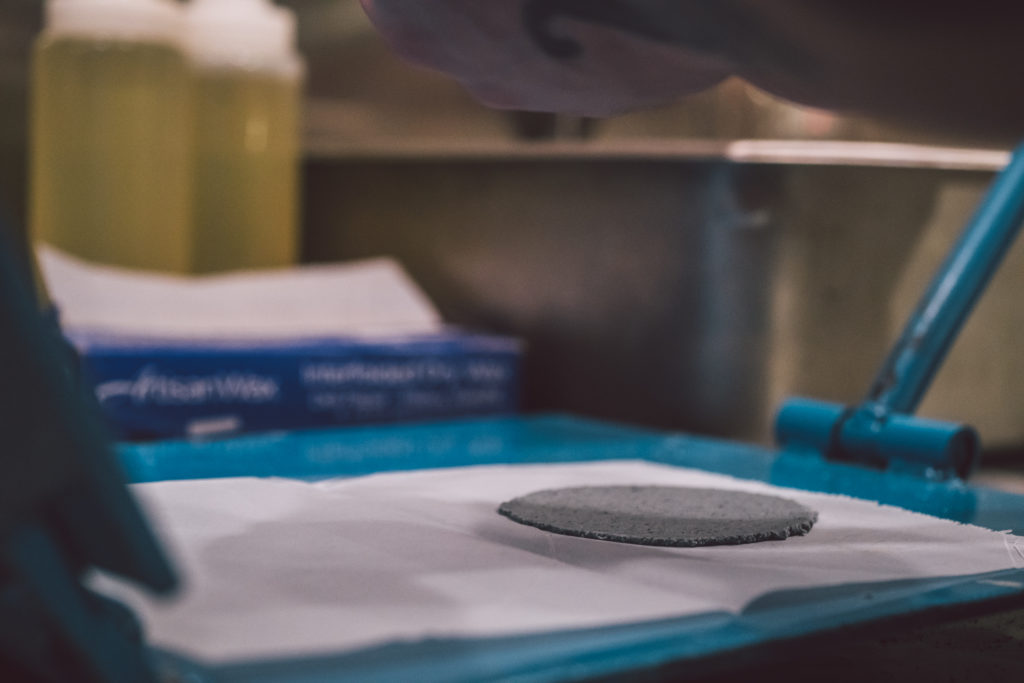 Tortilla making process. Photo by Timothy Patrick Clancy.
Tortilla making process. Photo by Timothy Patrick Clancy.
What’s your favorite vegetable to work with and least favorite?
Easy - I love chiles. I grew up eating chiles with my parents influence. Even as a kid I was eating raw habaneros macerated in lime and salt. Cooking with chiles is really special to me. I love carrots, and I really love corn obviously. It’s also really special to me, and I relish all the different ways it’s used. My least favorite is dandelion greens. I’ve tried cooking them tons of different ways, but they are just a little too bitter for me.
What advice would you give to a home chef who is trying to learn to cook with more seasonal vegetables?
I would say go to the farmers market and pick up something you have never cooked with before. Get on the internet and use it as a resource or use food magazines, like Bon Appetit and Food & Wine. They always have a lot of the latest food recipes and trends for seasonal vegetables. There's a lot of creative stuff that their staff puts together for recipes... it's really inventive and delicious. For savory cooking it doesn't need to be quite as accurate, and you can improvise a lot more. Be adventurous!
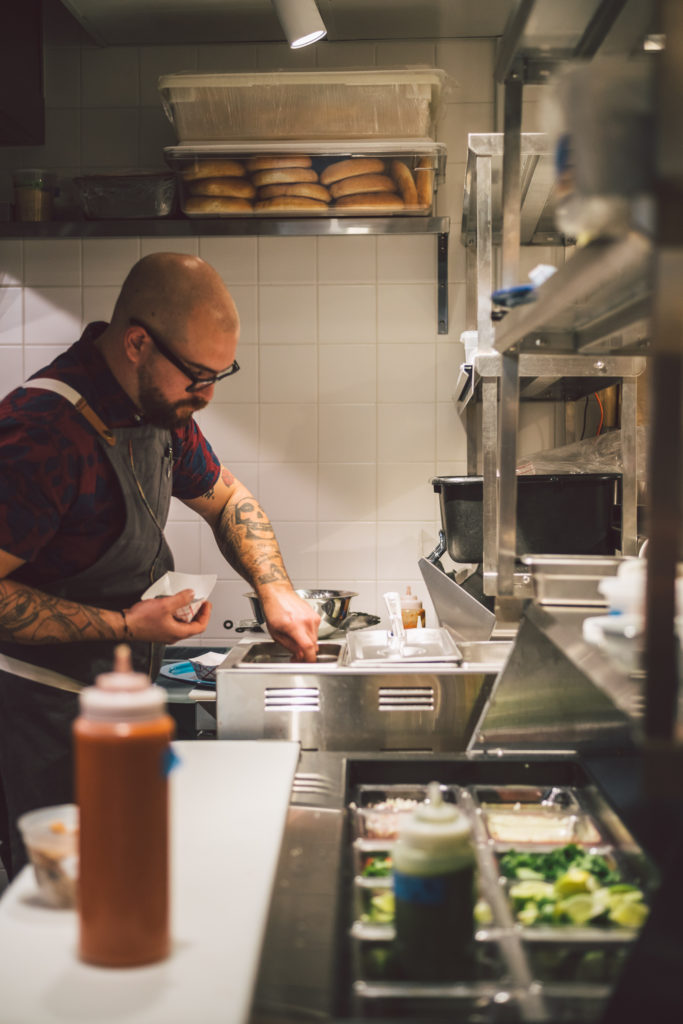 Kitchen scenes at the Taqueria. Photo by Timothy Patrick Clancy.
Kitchen scenes at the Taqueria. Photo by Timothy Patrick Clancy.
Any quick recipe or technique you’d like to share with our readers (with something in season)?
I really think right now sweet potatoes are really, really delicious. Something that we're doing on our cochinita pibil taco is pickling them fresh. So, since we don't have red onion right now, we're using sweet potatoes, julienned fresh and then pickled with chile piquin. That pickled sweet potato goes as a garnish on the taco, and it makes an amazing pickled item. My Sous chef, Mike Diaz, came up with the idea. Give it a try!
A huge thank you to Gabe Erales for taking the time to speak with us this week and Timothy Clancy for the amazing photos! Find more photos on his site or on his Instagram.






 0 ITEMS IN CART
0 ITEMS IN CART 

